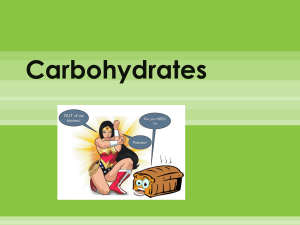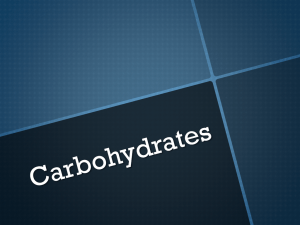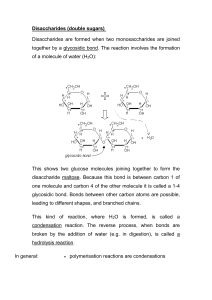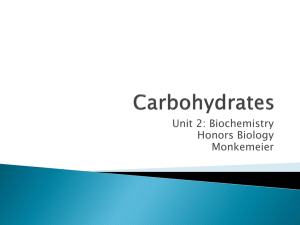Ch 3 - Carbohydrates
advertisement
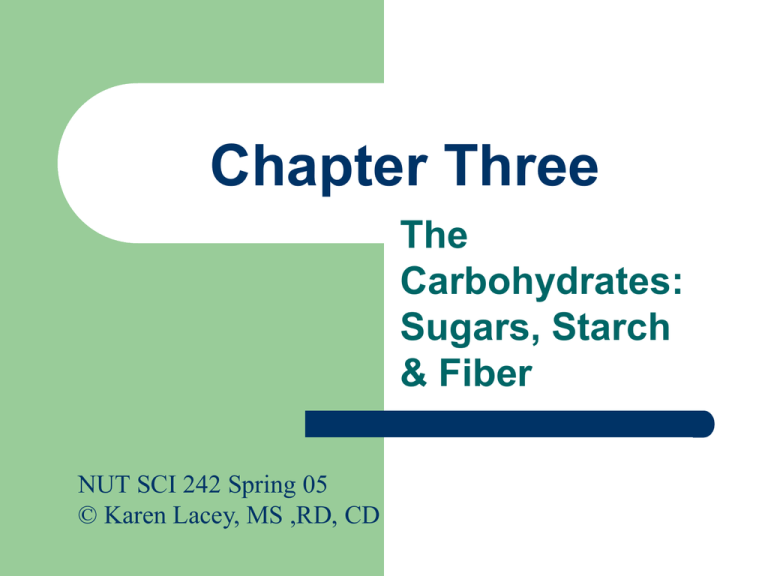
Chapter Three The Carbohydrates: Sugars, Starch & Fiber NUT SCI 242 Spring 05 © Karen Lacey, MS ,RD, CD I. Carbohydrate Basics Compounds composed of carbon, hydrogen, and oxygen atoms. The primary role: energy source – 4 cal/gram Ideal fuel for the body Two types: – Simple – Complex II. Simple Carbohydrates Structure: – – A single sugar (Monosaccharide) A pair of two sugars linked together (Disaccharide) 6 carbons in ring form All are chemically similar to glucose and can be converted into glucose A. Monosaccharides 1. 2. Glucose “blood sugar” used for energy Found in fruits, vegetables, honey Fructose Sugar of fruits, honey, maple & corn syrup Cont’d 3. Galactose Part of milk sugar B. Disaccharides (double sugars) 1. Two sugar units linked together Sucrose Glucose + Fructose Table Sugar Cont’d 1. 2. Lactose Glucose + Galactose Milk sugar Maltose Glucose + Glucose Product of starch breakdown After eating sugar, intestinal enzymes split the double sugars into single sugars. C. Sugar & Health Guidelines recommend limiting sugar in the form of sweets to less than 10% of calories. Sugar is an “empty calorie” food. Evidence on sugar – Causes dental decay & gum disease – Low nutrient content – Promotes and maintains obesity D. Keeping Sweetness in the Diet Read food labels for clues on sugar content Use less added sugar Limit soda, surgary cereals, candy Choose fresh fruits or those canned in water or juice III. Complex Carbohydrates Long chains of sugars (glucoses) arranged as starch or fiber Also called polysaccharides Two types – – Starch Fiber A. Starch A plant polysaccharide composed of hundreds of glucose molecules, digestible by human beings The storage form of glucose in plants Found in grains, vegetables, legumes B. Adding Whole Foods to the Diet A whole food is one that is altered as little as possible from the plant or animal tissue from which it was taken. Whole foods have a nutritional advantage over their empty-calorie processed forms. Parts of a Wheat Kernel Germ: the nutrient-rich and fat-dense inner part of a whole grain Endosperm: the bulk of the edible part of a grain; contains starch & protein Bran: the fibrous protective covering of a whole grain & the chief source of fiber Husk: the outer, inedible covering of a grain C. The Bread Box Terms: – Refined: the process by which the coarse parts of food products are removed – Enriched: the process by which the B vitamins thiamin, riboflavin, niacin, folic acid & the mineral iron are added to refined grains & grain products at levels specified by law Cont’d – – Fortified Foods: foods to which nutrients have been added Commonly eaten foods are fortified with nutrients such as iodine, vitamin D or calcium to help prevent a nutrient deficiency or to reduce the risk of chronic disease Whole grains: a grain that is not refined D. Fiber The indigestible residues of food, composed mostly of polysaccharides Yields few calories, if any Helps support plant structure Two types: – Insoluble – Soluble Cont’d Insoluble fiber – Does not dissolve in water – Cellulose, hemicellulose & lignin Soluble fiber – Either dissolves or swells in water – Pectin, gums, mucilages & some hemicelluloses E. Health Effects of Fiber Fiber in the diet is associated with several diseases – Digestive tract: Maintain health & function – Cardiac: Helps control blood cholesterol – Diabetes: Moderates blood glucose levels – Cancer: Hinders action of cancer-causing agents – Obesity: May help prevent obesity Different forms of fiber have different health effects Cont’d TOO MUCH FIBER? – No RDA; recommended is 20-35 grams per day – Too much fiber can: Cause dehydration Carry minerals out of the body Cause nutrient and energy deficiencies from eating too much bulk in the malnourished, elderly and children F. Adding Fiber to Your Diet Foods that are high in fiber include: – Plant foods (especially those with skins & seeds) – Whole grains – Fruits – Vegetables IV. How the Body Handles Carbohydrates Maintaining blood glucose levels B. Hypoglycemia C. Hyperglycemia (Diabetes) A. V. Alternatives to Sugar Minimal or no calories Many times sweeter than sugar Current products: – Saccharin – Aspartame – Sucralose – Acesulfame
